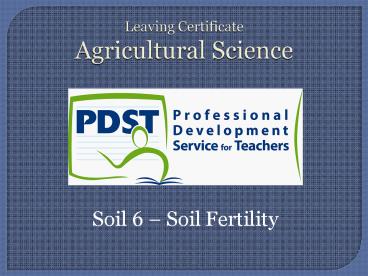Leaving Certificate Agricultural Science - PowerPoint PPT Presentation
Title:
Leaving Certificate Agricultural Science
Description:
Soil 6 Soil Fertility All plants require certain elements and minerals to carry out functions in the plant. These minerals allow for proper growth of the plant. – PowerPoint PPT presentation
Number of Views:87
Avg rating:3.0/5.0
Title: Leaving Certificate Agricultural Science
1
Leaving Certificate Agricultural Science
Soil 6 Soil Fertility
2
Soil Fertility
- All plants require certain elements and minerals
to carry out functions in the plant. - These minerals allow for proper growth of the
plant. - A lack of the minerals results in a deficiency
disease or stunted growth. - An essential element is defined as a chemical
element required for the normal growth of the
plant. - Some elements are required in large amounts and
they are called macro elements. The others are
called micro elements and are only required in
small amounts.
3
Macro Elements
Macro Mineral Role in Bodily Function Deficiency Symptom
Calcium Ca Builds bones and Teeth Secretions in milk Hypocalcaemia (Milk Fever) Rickets Lameness
Phosphorus P Formation of nucleic acids Carbohydrate metabolism Depraved appetite Poor fertility / Milk yield
Potassium K Muscle and nerve excitability Osmotic Regulation Dehydration
Sodium Na Transmission of nerve impulses Active Transport Dehydration Poor Growth
Chlorine Cl Gastric Juices Alkalosis
Magnesium Mg Metabolic Function Hypomagnesaemia (Grass tetany)
4
Micro Elements
Micro Minerals Role in Bodily Function Deficiency Symptom
Iron Fe Haemoglobin formation Anaemia in milk only fed Animals
Copper Cu Protein formation Poor Growth / Infertility
Manganese Mn Metabolic functions Reproductive failure Depressed. Delayed Oestrous Abortion
Zinc Zn Skin, hair, wool and hoof Weak hooves, lameness, Mastitis, high S.C.C.
5
Nitrogen
- Nitrogen is an important component of plant
proteins, chlorophyll and nucleic acids
therefore it is vital for growth, photosynthesis
and cell reproduction. - It is the most important and widely used
fertiliser element. - A deficiency in N causes sharp reductions in crop
yields. - When N is abundant in soil, the crop grows
quickly, is dark green in colour and fruits and
seeds have high protein levels. - When N is short, growth is restricted and the
plant goes yellow.
6
The Nitrogen Cycle
7
The Nitrogen Cycle
- The significant parts of the Nitrogen Cycle are
as follows - i. Fertiliser Application
- Organic and Inorganic fertilisers contain N in
Urea, Ammonium and Nitrate forms. - ii. Nitrogen Fixation
- Nitrogen fixation is the process of changing
atmospheric nitrogen into other simpler forms
(e.g. NH4) - Rhizobium bacteria are found on root nodules on
legumes convert Nitrogen into a usable form.
(E.g. Clover) - iii. Organic Matter Breakdown
- When organic matter or manure is applied to
soil, the complex forms of N in the material are
converted in NH4
8
The Nitrogen Cycle
- iv. Nitrification
- Nitrification is the conversion of NH4
(Ammonium) into Nitrates using O2 - v. Plant Uptake
- The uptake of NO3- by plants completes the cycle
N begins at plants and end at plants. - vi. De-nitrification and Leaching
- De Nitrification occurs in wet, anaerobic or
waterlogged soils. It results in a loss of N from
the soil and its conversion to N2O or Nitrous
Oxide and N2 gas.
9
Soil Analysis
- Soil must be analysed to measure its fertility
and the fertiliser requirements. It involves
three steps - Soil Sampling
- Soil must be sampled in various areas of the
field considering different coloured areas
sloped areas. - Take a minimum of 25 samples, usually in a W
shape throughout the field are taken at root
level. - Mixing all of these samples makes a composite
sample.
10
Soil Analysis
- Soil Analysis
- Soil analysis generally means determining lime
requirements, available P and available K. - Most testing is carried out by Teagasc, in their
soil testing lab at Johnstown Castle. - Interpretation of soil analysis
- The results of the soil analysis are compared to
previous reference tests carried out by Teagasc. - This allows the technician to give guidelines
for the farmer on P and K application and liming
requirements.
11
Nutrient testing in soils
Test Reagent Positive Result
Nitrates Diphenylamine Blue colour
Phosphates Ammonium Molybdate Yellow precipitate
Sulphates Barium Chloride White cloudiness
Chlorides Silver Nitrate White precipitate




























![Anand Agricultural University - [AAU], Anand PowerPoint PPT Presentation](https://s3.amazonaws.com/images.powershow.com/9659762.th0.jpg?_=20210911123)


